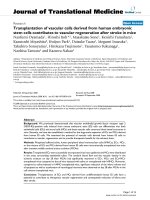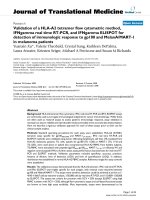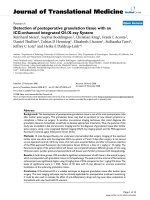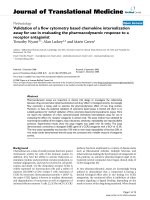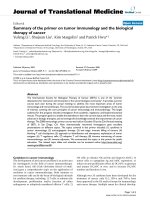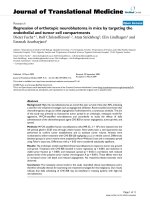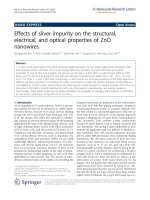Báo cáo hóa học: " Preparation of Pectin–ZnO Nanocomposite" pdf
Bạn đang xem bản rút gọn của tài liệu. Xem và tải ngay bản đầy đủ của tài liệu tại đây (393.24 KB, 5 trang )
NANO EXPRESS
Preparation of Pectin–ZnO Nanocomposite
L. Shi Æ S. Gunasekaran
Received: 5 August 2008 / Accepted: 2 October 2008 / Published online: 21 October 2008
Ó to the authors 2008
Abstract Pectin–ZnO nanocomposite was prepared in
the aqueous solution condition at room temperature. The
Fourier transform infrared, X-ray diffraction, and trans-
mission electron microscope (TEM) measurements
confirmed the nanoscaled structure of pectin–ZnO com-
posite. According to the TEM observation, the average
composite granules size was about 150 nm and the
embedded ZnO nanoparticles were uniform with an aver-
age diameter of 70 nm.
Keywords Nanocomposite Á Pection Á Zinc oxide Á
Nanocrystallinity Á Preparation
Introduction
Pectin is a natural, non-toxic, and amorphous carbohydrate
present in cell walls of all plant tissues, which functions as
an intercellular and intracellular cementing material. As a
secondary product of fruit juice, sunflower oil, and sugar
manufacture industries, pectin is both inexpensive and
abundantly available. Therefore, pectin is an excellent
candidate for eco-friendly biodegradable applications.
Pectin is commonly used in the food industry as a gelling
and stabilizing agent. Pectin macromolecules are able to
bind with some organic or inorganic substances via
molecular interactions. So, pectin can be used to construct
matrices to absorb desired materials and deliver them in a
controlled manner [1]. Indeed, pectin has been used to
fabricate delivery systems for controlled drug release [2],
implantable cell carriers [3], and so on.
Zinc (Zn) is an essential micronutrient critical for
human health, and its deficiency cause serious and some-
times even disastrous health problems [4, 5]. It has been
estimated that more than 50% of poor children and 30% of
non-poor children get \70% of the recommended dietary
allowance of Zn [6–9]. The main reason may be the
presence of phytate in staple foods such as cereals and
pulses; phytate has a strong negative effect on Zn absorp-
tion from composite meals. If suitable Zn fortificants can
be developed to fortify staple foods, it will go a long way in
alleviating Zn deficiency. Zinc oxide (ZnO), a safe source
for Zn supplementation and fortification, will decompose
into Zn ions after consumption [10]. Therefore, ZnO is
commonly used to fortify foodstuff in the food industry.
Wheat products fortified with ZnO have been shown to
possess good Zn absorption [11].
Currently, hybrid inorganic–organic nanocomposite
materials are of great interest because of their multifunc-
tionality owing to a combination of different compounds
incorporated [12]. We have recently reported preparation
of ZnO-whey protein isolate nanocomposite [13]. Nano-
composite of ZnO wrapped in pectin will survive the
gastric environment and become available in the intestine
and readily absorbed due to their nanoscale size. The
incorporation of nanocrystalline ZnO into pectin to form
nanocomposite may impart unique functionalities to the
nanocomposite prepared.
Herein we report the preparation of pectin-coated
nanocrystalline ZnO particles with a facile solution
approach at room temperature. This approach may find
potential application in the food industry.
L. Shi Á S. Gunasekaran (&)
Food & Bioprocess Engineering Laboratory, Department of
Biological System Engineering, University of Wisconsin-
Madison, 460 Henry Mall, Madison, WI 53706, USA
e-mail:
123
Nanoscale Res Lett (2008) 3:491–495
DOI 10.1007/s11671-008-9185-6
Experimental Methods
All reagents used were of analytical grade and were used
without further purification. In a typical procedure, 0.2 g
pectin, 1.2 g Zn(NO
3
)
2
Á 6H
2
O, and 40 mL distilled water
were added into a 100-mL beaker. After full dissolution,
40 mL of 0.125 M NaOH solution was added dropwise
under constant stirring. The reaction was allowed to pro-
ceed at room temperature (*20 °C) for 24 h. Then, the
obtained white precipitate was centrifuged at 10,000 rpm
for 10 min and collected and washed with distilled water
several times to remove the byproducts. After drying in
vacuum at 30 °C for 4 h, the final product was obtained as
white powder.
Fourier transform infrared (FTIR) spectra of the sample
were obtained with a Shimadzu IR-400 spectrometer with
the KBr pressed disks. The overall crystallinity of the
product was examined by a powder X-ray diffraction
(XRD) unit (Scintag Pad V with a Ge solid-state detector;
Cu Ka radiation) with the solid specimens mounted on a
low background quartz holder. Detailed microstructure
analysis was carried out using a transmission electron
microscope (TEM, PhilipsCM120). The UV–Vis spectrum
of the product dispersed in distilled water was recorded in a
UV–Vis spectrophotometer (UV-1601PC, Shimadzu Cor-
poration). A particle size analyzer (90Plus, Brookhaven
Instruments Corporation, New York, USA) was used to
determine the granular average size distribution of pectin–
ZnO nsnocomposite. Thermogravimetric analysis (TGA),
differential thermogravimetric analysis (DGA), and dif-
ferential thermal analysis (DTA) profiles were performed
with a Shimadzu-50 thermoanalyzer apparatus under
airflow with a heating rate of 10 °C/min.
Results and Discussion
Room temperature FTIR spectra of pectin and the as pre-
pared pectin–ZnO composite are shown in Fig. 1.An
obvious absorption peak at about 480 cm
-1
can be found
for the pectin–ZnO composite sample; this is a typical IR
absorption peak of ZnO, originating from stretching mode
of the Zn–O bond [14]. The remaining peaks in pectin–
ZnO composite are induced by pectin, which is confirmed
by comparing of the IR spectrum of the composite with that
of the pectin [15]. The peak at 1030 cm
-1
is assigned to
C=O or C=C double bond of pectin. The absorption peaks
at 1388 and 1633 cm
-1
are related to stretching bands of
COO
-
groups of pectin. The peak at about 2358 cm
-1
arises from the CO
2
atmosphere. It is found that the
intensities of two peaks at 1743 and 2944 cm
-1
(induced
by carboxyl and CH
2
groups of pectin, respectively) for
pectin–ZnO composite are obviously weaker than that for
pectin. This may originate from the participation of COO
-
and CH
2
groups in a hydrogen bond system, which stabi-
lizes the pectin conformation in solid state [16]. The above
results indicate that the final product is a true composite of
pectin and ZnO. The pectin peaks were not removed by
washing the sample repeatedly, suggesting that interactions
between pectin and ZnO are strong.
A typical XRD pattern of the as-prepared sample is
shown in Fig. 2. All the diffraction peaks can be indexed to
those of hexagonal ZnO. The lattice constant obtained from
the XRD data are a = 3.249 A
˚
, c = 5.212 A
˚
, which are
consistent with the reported values for ZnO (a = 3.253 A
˚
,
c = 5.209 A
˚
, JCPDS card, No. 80-0075). The broadening
of the ZnO XRD peaks suggests a nanoscale grain size.
3600
pectin-ZnO
pectin
Transmittance (a. u.)
Wavenumber (cm
-1
)
480
1030
1388
1633
2358
2944
1743
3000 2400 1800 1200 600
Fig. 1 Room temperature FTIR spectra of pectin and the as prepared
pectin–ZnO composite
30 32 34 36 38 40
101
002
100
Intensity (a. u.)
2θ (degrees)
Fig. 2 XRD pattern of the as prepared pectin–ZnO composite sample
492 Nanoscale Res Lett (2008) 3:491–495
123
The average particles size was calculated to be 60 nm
based on the Scherrer equation.
Figure 3 shows the room temperature UV–Vis absor-
bance spectrum for the as prepared sample. A narrow
absorbance peak centered at 371 nm was found. The band
gap of the ZnO nanoparticle was calculated to be 3.34 eV
under the current measurement condition, consistent with
the reported value for bulk ZnO [17], which indicates that
crystallinity of ZnO in the composite is as good as (or even
better than) that for ZnO prepared with other methods. This
may be due to the slow process and long time reactions at
room temperature. No blue shift, induced by quantum
confinement related effect, was observed in the UV–Vis
absorbance spectrum. The asymmetry of the peak was
caused by light scattering due to the insolubility of nano-
scale pectin–ZnO particles in water [18].
A typical TEM image of the pectin–ZnO composite is
shown in Fig. 4. The obviously different contrast on every
particle indicates its different composition and structure,
where the dark part is ZnO and the gray part is pectin. The
ZnO particles are all wrapped with pectin and have an
average size of about 70 nm. The composite granules are
irregular and their average size is about 150 nm according
to the TEM observation. The inset in Fig. 4 is a magnified
TEM image of a composite particle, which indicates
clearly the ZnO parcel (dark area) is wrapped with pectin
(gray area).
The granular size distribution of pectin–ZnO composite
examined with a particle size analyzer is shown in Fig. 5,
which indicates that the composite granular size distributes
mainly at about 150 nm. This is consistent with the TEM
observation result.
Thermogravimetry is one of the most widely used
techniques to monitor the composition and structural
dependence on the thermal degradation of a composite.
Figure 6 shows the results of thermogravimetric analyses
(TGA, DTG, and DTA) of the pectin–ZnO composite. The
DTG curve shows an initial peak between 40 and 110 °C
with a weight loss of up to 12%, which was related to
moisture evaporation. After this peak, DTG shows one
sharp peak and two small peaks in the range of 110 to
220 ° C, These three peaks may arise from the loss of
chemical bonding water. Two obviously endothermic
peaks can be observed in the DTA curve between 40 and
200 ° C, corresponding to the loss of water in the sample. A
strong peak started at 220 °C with the maximum at 258 °C
can be found in the DTG curve, it is induced by the thermal
300
Absorbance (a.u.)
Wavelen
g
th (nm)
400 500
Fig. 3 UV–Vis absorbance spectrum of the pectin–ZnO composite
Fig. 4 TEM image of the composite of pectin-wrapped ZnO
nanoparticles. The inset is a magnified TEM image of a pectin–
ZnO composite particle which indicates clearly the ZnO is wrapped
with pectin
100
0
30
60
90
Counts
D (nm)
200 300
400
Fig. 5 Histogram of granular size distribution of pectin–ZnO com-
posite sample
Nanoscale Res Lett (2008) 3:491–495 493
123
depolymerization of pectin chains. Accordingly, this ther-
mal event also caused a broad exothermic peak in the range
of 220 to 330 °C in the DTA curve. The temperature for
thermal depolymerization of pectin chains in pectin–ZnO
composite is about 20 °C higher than that of pectin alone
[19], revealing the depolymerization has been hindered to
some degree. This may be due to the existence of strong
interactions between pectin molecules and ZnO. The sim-
ilar influence of ZnO on the degradation of polymer has
been reported [20]. The last sharp DTG peak centered at
415 ° C accompanied by a strong exothermic peak in the
DTA curve should arise from the oxidation decomposition
of pectin in the air [21].
It is well known that the ZnO can precipitate from
alkaline aqueous environment via the hydroxide. The main
Zn species in hydrothermal alkaline solution are ZnOOH
-
,
Zn(OH)
4
2-
,ZnO
2
2-
, the transport, and growth processes
can be described as:
Zn(OH)
2À
4
! Zn(OH)
2
+ 2OH
À
;
Zn(OH)
2
! 2H
þ
+ZnO
2À
2
:
The two oxygen atoms of zinc hydroxide are highly
repulsive since they all have lone pair of electrons. This
makes the dehydration of zinc hydroxide quite quickly at
low temperature and facilitates the production of ZnO
nanoparticles. Due to the high polarity of water, ZnO
nanoparticles usually agglomerate immediately and form
larger particles. In our approach, pectin is added into the
solution and bind with ZnO molecules with COO
-
and
CH
2
groups in a hydrogen bond system to restrain the
formed ZnO nanoparticles from further agglomeration by
the action of steric hindrance. After a long time reaction,
the pectin-wrapped ZnO nanocomposites are formed.
Summary
We developed a novel yet simple approach to prepare
pectin–ZnO nanocomposite in aqueous solution at room
temperature. The structural properties, morphology, ther-
mal decomposition process, and optical absorption of the
nanocomposite were studied. The experimental results
confirm the true pectin–ZnO composite structure and the
existence of strong interaction between pectin molecules
and ZnO. This method may be extended to prepare other
hybrid inorganic–organic nanocomposite materials.
References
1. L.S. Liu, P.H. Cooke, D.R. Coffin, M.L. Fishman, K.B. Hicks, J.
Appl. Polym. Sci. 92, 1893 (2004). doi:10.1002/app.20174
2. T.F. Vandamme, A. Lenourry, C. Charrueau, J.C. Chaumeil,
Carbohydr. Polym. 48, 219 (2001). doi:10.1016/S0144-8617(01)
00263-6
3. L.S. Liu, M.L. Fishman, J. Kost, K.B. Hicks, Biomaterials 24,
3333 (2003). doi:10.1016/S0142-9612(03)00213-8
4. S. Frassinetti, G. Bronzetti, L. Caltavuturo, M. Cini, C. Della
Croce, J. Environ. Pathol. Toxicol. 25, 597 (2006)
5. R. Tudor, P.D. Zalewski, R.N. Ratnaike, J. Nutr. Health Aging 9,
45 (2005)
6. H.H. Yu, Y.S. Shan, P.W. Lin, J. Formos. Med. Assoc. 106, 864
(2007). doi:10.1016/S0929-6646(08)60053-4
7. G. Fanjiang, R.E. Kleinman, Curr. Opin. Clin. Nutr. 10, 342
(2007)
8. N.F. Carvalho, R.D. Kenney, P.H. Carrington, D.E. Hall, Pedi-
atrics 107, e46 (2001). doi:10.1542/peds.107.4.e46
9. S. Sazawal, U. Dhingra, S. Deb, M.K. Bhan, V.P. Menon, R.E.
Black, J. Health Popul. Nutr. 25, 62 (2007)
10. C. Hotz, K.M. Brown, Food Nutr. Bull. 25, S95 (2004)
11. D.L. de Romana, M. Salazar, K.M. Hambidge, M.E. Penny, J.M.
Peerson, N.F. Krebs, K.H. Brown, Am. J. Clin. Nutr. 81, 637
(2005)
12. K.X. Yao, H.C. Zeng, J. Phys. Chem. B 111, 13301 (2007). doi:
10.1021/jp075954r
13. L. Shi, J. Zhou, S. Gunasekaran, Mater. Lett. 62, 4383 (2008).
doi:10.1016/j.matlet.2008.07.038
14. S. Maensiri, P. Laokul, V. Promarak, J. Cryst. Growth 289, 102
(2006). doi:10.1016/j.jcrysgro.2005.10.145
15. I.I. Shamolina, A.M. Bochek, N.M. Zabi Valova, D.A. Med-
vedeva, S.A. Grishanov, Fibres Textiles East Eur. 11, 33 (2003)
50
75
100
-3
-2
-1
0
0
-2
0
2
Temperature (
o
C)
TGA(%wt)
DTG(%wt/min)
DTA(
µV/mg)
Temperature (
o
C)
200 400 600 800
0 200 400 600 800
Fig. 6 TGA, DTG, and DTA curves for pectin–ZnO composite
sample
494 Nanoscale Res Lett (2008) 3:491–495
123
16. A. Synytsyaa, J.C. Opikovaa, P. Matejkab, V. Machovic, Car-
bohydr. Polym. 54, 97 (2003). doi:10.1016/S0144-8617(03)00
158-9
17. Z. Li, Y. Xiong, Y. Xie, Inorg. Chem. 42, 8105 (2003). doi:
10.1021/ic034029q
18. Q.F. Zhang, T.P. Chou, B. Russo, S.A. Jenekhe, G. Cao, Adv.
Funct. Mater. 18, 1654 (2008). doi:10.1002/adfm.200701073
19. A. Ghaffari, K. Navaee, M. Oskoui, K. Bayati, M. Rafiee-Teh-
rani, Eur. J. Pharm. Biopharm. 67, 175 (2007). doi:10.1016/
j.ejpb.2007.01.013
20. I.C. McNeil, M.H. Mohammed, Polym. Degrad. Stab. 48, 189
(1995). doi:10.1016/0141-3910(95)00031-G
21. S. Ouajai, R.A. Shanks, Polym. Degrad. Stab. 89, 327 (2005).
doi:10.1016/j.polymdegradstab.2005.01.016
Nanoscale Res Lett (2008) 3:491–495 495
123
